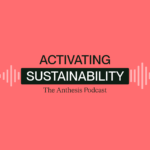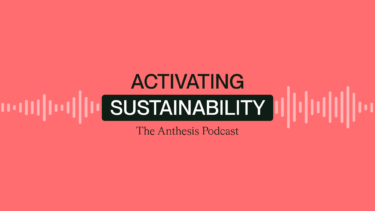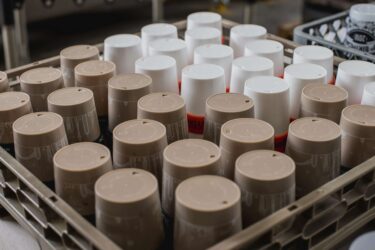
Speakers
Chris Peterson – Director
Peter Slorach – Principal Consultant
Anna Brockhaus – Associate Director
Related Topics
Share this episode
In this episode of our Activating Sustainability series, our host Chris Peterson is joined by Anthesis Principal Consultant Peter Slorach and Associate Director Anna Brockhouse to explore life cycle assessments (LCAs). The conversation delves into the basics of LCA, its importance in evaluating environmental impacts across product life cycles, and how digital tools such as Anthesis PortfolioPro are revolutionising LCA scalability and accuracy, especially for Scope 3 emissions.

Read the transcript
Chris Peterson: Hello, and welcome to Activating Sustainability the Anthesis podcast. I’m your host, Chris Peterson. After a short summer break for this series, we’re back and we’ll be exploring the key trends, topics and tactics driving sustainable performance.
To kick us off, we’re starting today with a beginner’s guide, an intro guide to life cycle assessment and are joined by, Peter Slorach, UK lead for the LCA and based out of the Sustainable Products team, and Anna Brockhaus, Associate Director from the Digital team. So thank you both so much for joining.
Peter Slorach: Thank you.
Anna Brockhaus: Thank you very much for having us.
Chris Peterson: Well, great. Maybe to kick us off, Peter, could you provide kind of a high level view of what is lifecycle assessment and LCA?
Peter Slorach: Yep, of course. So LCA is an approach to consistently assess multiple environmental impacts. Of products or services across their entire life. So we consider everything from the extraction of raw materials through its manufacturing, its use, and then it’s end of life. So when everyone, whenever someone talks about something like a carbon footprint, whether that be someone’s annual emissions or a product sitting on a supermarket shelf, that carbon footprint will have been assessed either directly or indirectly through the use of a life assessment.
Chris Peterson: Great. And maybe could you provide us a little bit of insight in terms of what does that process look like? I feel like it’s one of the, it almost feels like a black box or is often referenced as a black box. So maybe just if you could describe some of the big steps within it? It would help myself and others to understand what does that process really look like?
Peter Slorach: Yeah, so the first step is to define what the purpose and the goal of that life cycle assessment is. So what’s the functional unit? So what is it you are trying to assess? So that may be a single food product that’s consumed, or it may be driving a mile in a car and you’re comparing different cars.
And to do that, the main challenge there is to collect the data from the client on the company who are wanting to do that life cycle assessment. So they will typically understand their process really well. They’ll know what materials go into manufacturing. They’ll know what electricity they buy.
And it’s our job to frame what data needs to be collected in order to assess the impacts of all of those activities. So once we fully understand the process and have collected data for the materials, the manufacturing, it is then. about mapping those materials to impact factors and mapping those processes to impact factors where we can then decide and quantify the emissions associated with those activities.
So once we can add that together across all of the life cycle stages of that product, we can then get a holistic view on the environmental impacts of that product over its life cycle. Primarily people understand this by being a carbon footprint, but we can also assess land, water, acidification, smog. Any number of environmental impact factors can be assessed using a life cycle assessment.
Chris Peterson: Great. Yeah. And I’m always amazed at how deep LCA goes within the space, right? And just that ability to get that holistic view, like you said, Peter, and really being able to understand and answer some of the really complex questions. I know one of the challenges that LCA has faced is how do you scale that?
And maybe, Anna, shifting to you and the digital piece, I know that there’s been a lot of development within the space on the digital front. So maybe you could introduce what that is looking and how things are developing both within Anthesis and more broadly.
Anna Brockhaus: Yes, sir. Happy to do that. So I think you already touched on a really important point that over the last, probably a couple of years, the development and the movement in the market generally for kind of software related sustainability products. So a lot is happening on the greenhouse gas inventory side, but also in the product footprinting side. As Peter was just explaining, software companies and other kind of smaller startups are really starting to introduce software tools to capture a lot of that analytical part and to basically scale a lot of that movement and calculation in the background.
So that also shows the appetite of the market more generally to on the one side scale and also to give clients and users this interactivity and the dashboard where they can play around with the data themselves. Anthesis has also already been on the, let’s say, digital journey for a number of years, and we’ve really started to build a suite of different software tools that basically pick up a lot of the analytical part from GHG inventories to LCA, to capture all of our knowledge in a digital tool, which then clients can interact with themselves, they can create scenarios and then they can also play around with the results,
kind of as in if they as in when they need to. And one of those software products that we’ve been working on for the last couple of years is basically also an LCA tool. So it’s. It’s capturing a lot of the methodology that Peter was describing in terms of really looking at product life cycle from the first step to the last step but the focus is much more, how can we scale this approach?
So it’s not necessarily looking at the assessment for one individual product, but it’s really about how can we take that to a portfolio level? So types of projects or kind of services that previously would have been very manual and sometimes also out of scope, companies don’t have enough resources to to basically enable those types of projects-
that’s really where the digital part comes in – to take that knowledge and then scale that across portfolios. Some companies have hundreds of thousands of different SKUs, it would be impossible to do a detailed LCA for hundreds of thousands of SKUs. So that’s basically then where the digital arm comes in and really fills that gap that previously was just very difficult to cater for clients.
Chris Peterson: That’s great. And give some good understanding of what are we talking about? What is the state of play within the space? And we’d love to shift the focus a little bit to what are the types of, specific challenges building off some of the ones that both of you have identified already; that clients are looking for solutions around that LCA is a key tool for, or a digital solution really helps them to address, say, within the portfolio, as you were saying, Anna.
So maybe starting with you, Peter, what are some of those key client problems or desired outcomes that people are looking for value that they’re able to extract from LCA?
Peter Slorach: Yeah, I’d step this back a bit and say exactly why and when a client is wanting to use an LCA. Of course, you can do an LCA for a client at any stage of their product development. And one area we think is super useful and we’d recommend a lot is for clients to use a lighter touch sort of screening LCA when they’re developing a product to assist them in making sustainable design choices.
Because we understand as with any other development of whether it’s building or anything else, it’s the easiest time to make changes is before the product has gone into full development. LCA should, in its best case, be used as a decision making tool. If a company have a range of scenarios, they are thinking it’s feasible for this product.
Then, ideally, they’re using lifecycle assessment at that design phase to make decisions as to which of those options has the lowest impact. We can use a standalone LCA to provide those high level, a very detailed hotspot analysis of the impacts of those different options and provide, tailored recommendations for how they can make that product sustainable as possible.
It may also be the case that they want to assess a huge range of different products or product options, in which case a digital tool such as that described by Anna would be the best choice in that scenario.
Once the product is fully developed, we’re seeing the clients are more looking to make green claims. In order to do this, they need to be stepping up the detail of this LCA to a full ISO standard, which means that it will be externally reviewed. And this would be a requirement of the UK Green Claims Code and the European Green Claims Directive.
So this means that a fully assured ISO standards report is created, which explores the uncertainties, sensitivities of the data we’ve put into a lifecycle assessment. And that is the sort of advisory service that we provide at Anthesis to give our clients full confidence in making a green claim to its customers which they can be confident isn’t going to be challenged by the Advertising Standards Authority or the CMA.
Chris Peterson: Great. Yeah, it’s amazing to hear that spectrum because I think often people think of LCA is that very deep dive academic, effort that produces a really substantial report. And I know in some of the engagements I’ve had with our LCA team and others is that sense of this becomes the sole source of truth, but also becomes something that can feel like overwhelming of as to your point, and we just can’t do that for thousands of SKUs, so great.
Great to hear Peter, your concept of yeah, there’s a spectrum here.
Peter Slorach: It’s excellent you say that. We also want to Reinforce those two end of the spectrum are very much connected So if you are doing a screening LCA when you’re developing your product that is already laying the groundwork for doing A more in depth ISO standard LCA once the products have developed and you’re ready to go to market with a finished product and make a green claim around that.
So you wouldn’t want to do that full ISO standard report at the outset because the data is going to change. But once you have that fixed product, it’s when you can escalate that LCA to a full ISO standard and whether that first stage is done in a digital offering or the standalone offering is both very viable.
Chris Peterson: Yeah, no, that’s great. And I love, Bring that through to the value piece. I know in some of the like LCA I was involved in decades ago that, there seemed to be this kind of, it was done off in isolation and not necessarily tied into like, how do we then leverage that to identify, major risk reductions throughout our value chain, et cetera, et cetera.
And so we’d love if you could just expand a little bit on the value piece that you see. From organisations in terms of like you mentioned, some of the ISO reporting and maybe some of the other pieces through the value chain or cost reductions that come into that.
Peter Slorach: Yeah, I think one way to think about that is that most companies are going to be very familiar with GHG inventories and net zero strategies. And essentially a corporate inventory is a high level lifecycle assessment of an entire business’s operations. So when you’re looking at scope one and scope two it’s very likely you’ll get very good primary data.
Whereas where companies are looking at scope three, when they’re looking at purchase goods and services they’ll be typically looking at spend data. So if a company wants to make strategic decisions, they need to be able to understand their whole portfolio of products and activities in detail to make tailored and bespoke recommendations and actions to achieve a net zero strategy.
So our, one of our key recommendations is using LCA to better understand scope three emissions. And this is particularly where the digital tool comes in. You can understand a whole range of products using a life cycle approach , because once you understand the actual impacts of your purchase goods and services from your specific supply chain and not using just generic impact factors, you have unlocked a whole new level of insights as to where your impacts are coming from.
And the LCA will provide those bespoke recommendations for actions to integrate into a net zero strategy or a carbon reduction strategy. It’s probably a good time to pass over to Anna to think about how the digital tool can encompass that much broader scope than a standalone LCA.
Anna Brockhaus: Yes, happy to jump in here. So basically, as Peter was already mentioning the, due to the kind of scalability opportunities that a digital solution offers us, we can really try to enhance the scope three reporting part, and also the data granularity that sits behind that. So instead of going from really high level data and sometimes also very inaccurate data for your scope three reporting, we can use PortfolioPro, which is the, our digital LCA tool to really build up this view from the bottom up to really look into what are the products that we’re selling?
What is actually behind the cover to then use that data output and ingest that into scope three or general GHG accounting processes. And what the digital solution will also offer us is really looking at this next step in terms of how would it change? How would my impact change if I switched all of my material a and my portfolio to my material B? Or how would it change if I
sourced all of my metals from a different supplier or a different country. So it really allows you to look at your changes and your net zero strategy action plan on a much more granular level and also in a much more kind of action oriented level. And it will also then enable you to see those outputs pretty much straight away on the dashboard.
You can say, okay, change A to B, or you might lightweight certain products. And you will see that change immediately without having to go through the actual R&D process. You can basically do your scenario and your planning in the software tool, which will then also start to inform your R&D or other departments to really take that information forward and say, okay, how can we make our products more sustainable to
go into our net zero strategy, but also on a more general perspective. So that scalability and that interactivity with the user is really where the digital solutions sit alongside the advisory and the more traditional LCAs that will then, once a product has actually been developed, will still give you that ISO compliant reporting to then say, my product is much better than it used to be.
And really give you that accreditation that is needed for for the next steps.
Chris Peterson: That’s great and maybe a question about kind of audience for this. Anna, you described kind of those scenario pieces and being able to have a little bit of that dashboarding for, and I can picture those coming into product development meetings, right? Of Hey, we’re doing AB testing
this is what the outcomes are. Peter, some of the things you’ve referenced as well in terms of that decision making within the organisation. I’m just curious if maybe both of you could speak a little bit to who is the, maybe the owner of LCA within the organisations you’re working with, but then also who’s the audience for those LCA’s.
Anna Brockhaus: Peter, do you want to go ahead first with the kind of general LCA?
Peter Slorach: Yeah, I think from a general LCA approach, we are often working with the sustainability leads in the company, but that is normally them interfacing us with one of their product development teams. Typically in the last year or two, the trend has been to be looking at different packaging options. So we’ve worked a lot with R&D packaging teams.
So they have been interfacing with different suppliers. So they want to understand new novel materials, whether there’s paper based products or bio based products, where they are wanting more expertise as to what the true life cycle impacts are of these new novel packaging materials. So we are
acting as interface between their sustainability leads, the R&D teams, but also these companies suppliers. So working directly with them to help them provide life cycle data to make for the our clients to make a decision as to whether they want to purchase or use those suppliers products.
So it’s often many stakeholders involved and then, the outputs of this will typically be a technical report, which is very of interest to the R&D teams and can often be shared with their suppliers as well. So it can be a collaborative approach to understanding that life cycle data. But then, ultimately, the sustainability leads will be presenting this to more senior decision makers.
So we’re producing summary reports, which provide very clear recommendations, very clear findings without overwhelming a reader with all of the methodology, all of the assumptions, all the limitations, which are there in the background and they’re super important for an LCA, but we have to distill this, as you say, academic pursuit into a meaningful recommendation and decision making, which can be understood by a lay audience who don’t want to get into the mud of the mechanics of an LCA.
Chris Peterson: I remember breaking the hearts of many an LCA team that produced an amazing report, which gave the most detailed and insightful overview of a value chain, that the organisation had ever seen and distilling that into 3 slides and I’m just like, their hearts just break it. It’s but the value of that, like you say, is just incredible.
Whereas where are you getting that from? And being able to be like, that’s page 112. Let’s go look at what those supplier options are and then to your part, really being able to inform that decision making around it. But
Peter Slorach: Yeah so we’ll have the R&D teams who are challenging one line of data on an individual table on page 68 of the report. Equally, we provide that 10 page PowerPoint for the wider audience who just want to be able to digest it in a much shorter amount of time.
Chris Peterson: yeah, no, it’s so exciting to see it being leveraged for that decision making, like you’re saying, and Anna as you think about PortfolioPro and, that gap that Anthesis is looking to fill within the digital space, are there some of those audience scenarios that are top of mind?
Anna Brockhaus: I think generally there’s probably a big overlap in terms of audience. And I think the different comes more in terms of what is the company trying to achieve? With kind of the application of an LCA or digital solution for LCA. So generally we’re also engaging a lot with sustainability leads and their R&D teams.
I would say what comes into play probably a bit more within the digital space might also be procurement teams if they’re looking into their different suppliers and they can really drill into which supplier is my material coming from? Can I maybe change from supplier A to supplier B? So that’s maybe one aspect that
might be less applicable for kind of more traditional LCAs. And then also, I would say similarly, as Peter was saying, the outputs are really aimed to drive decision making. So sustainability leads would typically take the outputs or the dashboard and present that to more senior stakeholders to really emphasize on the message that the outputs are trying to give to the company.
But yeah, I think in terms of the audience, it’s a big overlap in terms of who we’re trying to or who within our client’s organisation would actually be using and engaging with us on this topic.
Chris Peterson: Great. And I know throughout you both have hit on some of the things that you would look to do, or recommendations you would provide to organisations or individuals that are thinking about LCA or excited about the concept and would love to get your thoughts maybe at a high level. What are some of those success factors considerations that you would recommend people think about before they jump into this journey?
And then we can wrap up with what are 1 or 2 tactical things that you would recommend as an immediate next step, but maybe starting with you, Peter, you’d mentioned that potential of starting with the screening LCA, right? To get your feet wet and get that initial understanding.
But are there things you would expand on that? Or additional thoughts in terms of how you would recommend a friend goes through this process?
Peter Slorach: Yeah, I think the most important thing is that a company understands their data and they have access to their data to be able to proceed with an LCA. And that is the number one stumbling block in LCA is does the company understand its own data and its own products well enough to undertake that LCA?
Do they understand the limitations of the outputs if they aren’t going to be putting in high quality primary data? So we understand that the client is always going to be the expert in their product. We’re not coming in to tell them how to make their products. They know their products. We’re here to make recommendations and understand their process.
So we need them to be at a level where they know how it works to be able to share with us, to get the best insights possible. And after that, once the data is in place, really, Anthesis can go away and we can undertake that LCA. And at that point, the client are going to be delivered a high level report with good recommendations for how they can improve their product, understand the hotspots and, make clear recommendations for areas of the product which have the highest impact.
So really it’s just the data is the, is where we really need the client to understand what they’re
doing.
Chris Peterson: Yeah, and it must be fascinating being in the space to see that availability of data and quality data is just growing exponentially. Where it’s with CSRD and other mandatory reporting requirements, we’re definitely seeing this wider scale of it. So it must be exciting for those of you that are pulling teeth, trying to get data out of suppliers and various spots to have that availability.
Peter Slorach: Yeah, definitely two, three years ago, some of the data just would not have been available and it would have been, we’re not going to do, we’re not going to dig up all this data for an LCA. But now, as you say, it’s required for so many other regulations like CRSD that it’s now more readily available. So we can offer that more holistic offering where once we’re collecting this data for another delivery, then there’s an opportunity to offer an LCA using that data we’ve now collected.
I think to add one thing to this discussion, I think we’ve potentially pitted advisory LCA against digital LCA, but I think a unique offering of the PortfolioPro is that it is backed up by our Advisory team, so myself and our team. So we’re not just giving a client a digital tool to go away and use.
We are. supporting them with our LCA expertise and developing a bespoke dashboard for them to use, and Anna you may want to cover that in more eloquent detail in your response as well.
Anna Brockhaus: No, I completely agree on all of what Peter was saying that those two kind of sides of LCA really sit side by side, they are tailoring or they’re addressing slightly different client needs. So it’s really depends on what does the client want? What are they using the outputs for?
And then. We will propose the correct or the best fitting solution for that. But yeah, those two options are really highly interlinked and all of our LCA experts sit behind the tool and the development, so our knowledge and our skills have really gone into that to present the best possible outcome.
And maybe just one point also on the data part that Peter was saying, that is definitely also the case for any digital offering data is key, and I think Anthesis also is in a great position to link up our supplier engagement portal to really use that data that clients are already giving us for other purposes to really use that for the next step.
So to reduce all the different points of contact that the companies need to input data to do that into one portal and the data flows behind the scenes. That’s just also a really unique position in terms of actually getting that data from suppliers and using that for the next subsequent steps in their sustainability
Chris Peterson: That’s great. Yeah. And I know in our this channel, we had spoken with Richard Peagam and that idea of digitally enabling services, right? And I think exactly like you’re saying, Peter, you’re right in the weeds with clients of trying to access the data and which data is really important.
How do we pull that in? What’s the ideal? And it’s really exciting to see some of those digital tools start to come in. They’re really anchored in those very specific delivery needs and not just Anthesis consultant delivery needs, but very much in that. What are the client needs and how do we simplify this process within that?
Anna Brockhaus: Definitely.
Chris Peterson: Great. And any kind of final thoughts in terms of, where you would recommend people get started on this journey or take their next steps along it?
Peter Slorach: So I think my key recommendation would be if a company can commit to doing an LCA of one or maybe more products, whether they’re the highest selling or representative of their wider portfolio, then that is going to unlock impact hotspots and recommendations and insights, which are going to be applicable across their wider portfolio.
And the key part of an LCA is it’s telling the story of a product. So any insights you get from that LCA are excellent for telling a story internally, both to motivate employees at that company, but also to tell a story externally to customers. So writing that blog posts, writing a white paper to say, this is the story of our product.
And you can tell that story with flow charts, with graphs saying this is the impact of our life cycle stages and giving the consumer those insights into exactly how that product’s been made. And I think that transparency is what consumers want to be able to seeing now in their products. And LCA is a tool to be able to tell them that story.
Chris Peterson: Great, Anna?
Anna Brockhaus: I think probably coming more from the digital side, in terms of how to use it. I think Peter already covered that perfectly. I think from the digital perspective, it’s really looking at, do you have the data from your portfolio? How do you want to take that forward? And then if you are interested in maybe having this interactive usability, then do please get in touch to have a demo of the tool.
And we’re more than happy to yeah, to basically show clients of how they could maybe embed the software into their own systems and how really to drive the results and the decision making following on from the use of it.
Chris Peterson: That’s great. And yeah, I would just say it’s fascinating here that the two of you and how much I really appreciate the spectrum of solutions that you’re proposing. It’s very much that not just it’s a blunt tool of LCA, if you need to do an ISO compliant version of that, but really understanding what is it that the clients need and how best do we meet them where they are and what are those current challenges and then move them along that path where there’s value to capture, whether that’s through impact reduction or improved performance, et cetera.
Wonderful. Thank you both so much for the time and all the insights. We really appreciate it.
Anna Brockhaus: Thank you so much again for having us. It was great to be part of the Activator Sustainability Podcast.
Peter Slorach: Thank you.
Chris Peterson: Great. Thanks. And thank you all so much for listening. Please be sure to check out the resources on the podcast description, as well as on the anthesisgroup.com website, including a recently released guide to LCA and the new portfolio pro website, where you can also book a demo. As well as be sure to check out the podcast channel on the Anthesis site where there’s a whole bunch of new podcast streams to enjoy and dig in on.
So thank you all very much. Take care.
Inside this episode
- What is LCA and why it’s essential for understanding product impacts
- How digital tools like PortfolioPro enhance Scope 3 reporting and sustainability strategies
- Scaling LCAs for large product portfolios and scenario planning for better decision-making
If you have any feedback on the podcast, get in touch with our host Chris Peterson at: Chris.Peterson@anthesisgroup.com















